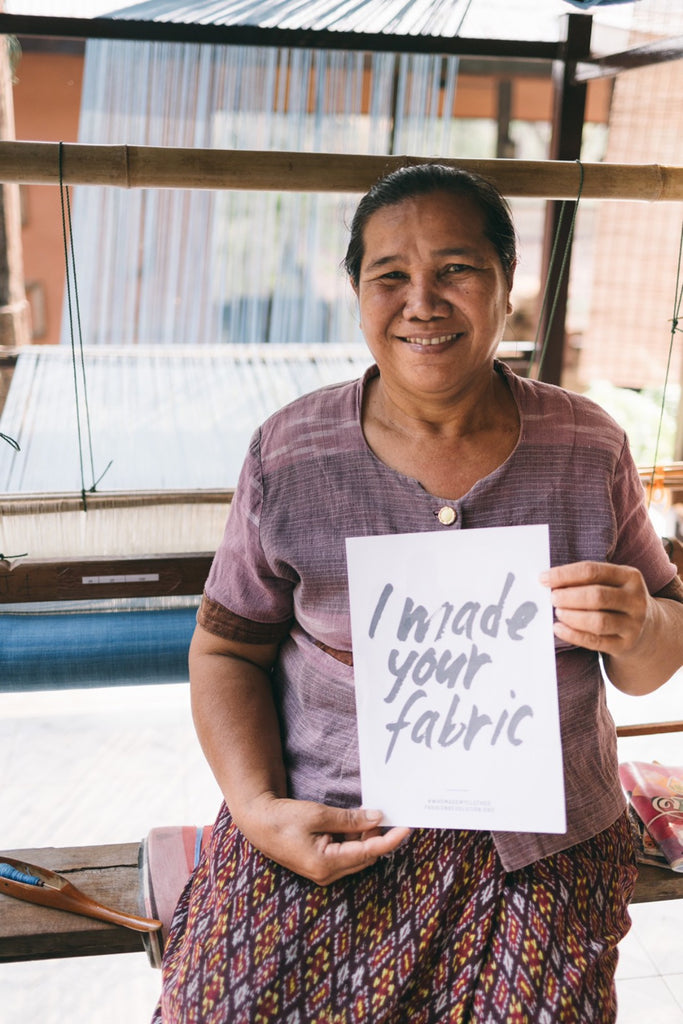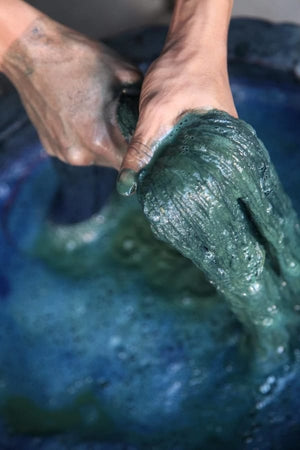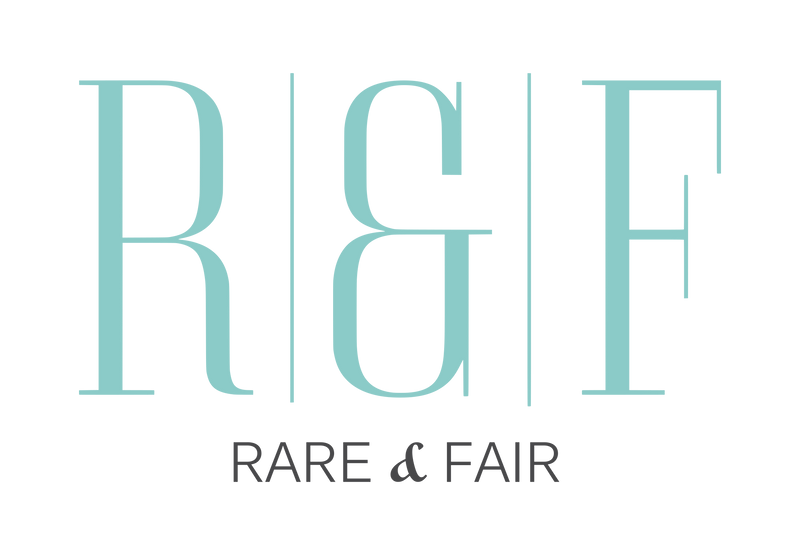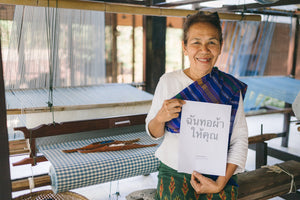April 19th-25th 2021 is Fashion revolution week! Excited? We are! Learn more about this year’s campaign and meet the faces behind our most popular fabrics.
If you have no idea what Fashion Revolution Week is or just need a recap, we'll start with a quick overview and tell you what's planned for this year.

What is Fashion Revolution Week?
Put simply, Fashion Revolution Week is an annual event that unites the global community to advocate for a better fashion industry.
How did Fashion Revolution start?
Fashion Revolution was founded in the wake of the collapse of Rana Plaza garment factory in Dhaka, Bangladesh on April 24 2013 - 1,134 people were killed and 2,500 others were injured.
The tragedy sparked massive global outrage and put a spotlight on the exploitative nature of the fashion industry, fuelled by some of our most beloved fashion brands.
Workers, activists, and consumers from all over the world demanded for basic human rights such as safe working conditions, and fair pay, as well as stronger environmental protections.
Fashion Revolution celebrates fashion but also seeks supply chain transparency and corporate responsibility from the global fashion industry. Fashion Revolution Week has grown immensely since it launched in 2013. It is now the largest global fashion activism movement in the world and has spread to 171 countries.
Fashion Revolution Week 2021: Rights, Relationship and Revolution
This year, Fashion Revolution Week’s focus is ‘Rights, Relationship and Revolution’. Their aim is to bring together people from across the global fashion community –“amplifying unheard and marginalized voices, and working together to explore interconnected solutions”.
You too can get involved in this crucial conversation and help bring change to the global fashion industry!

Who made my fabric?
During Fashion Revolution Week, people around the world are encouraged to ask brands “Who made my clothes?” using the hashtag #whomademyclothes? and #whatsinmyclothes? on Social Media.
Asking the question #whomademyclothes? is a great step towards safer working conditions and transparency of where brands and retailers clothes are produced.
We can all agree this is a fantastic initiative, but just showing where the garments are cut and sewn leaves a huge blind spot in the transparency of the supply chain and can even disguise a brands sustainability credentials.
That is why this year, the Fashion Revolution campaign is taking an extra step and calling on citizens everywhere to demand even greater transparency from brands by asking the question #whomademyfabric?
The Faces Behind our Fabrics
In honour of Fashion Revolution week and the #whomademyfabric? campaign, we thought now would be the perfect time to introduce you to the faces behind the fabrics of our most popular handwoven silk and cotton pieces.
Below we feature 10 of our incredible artisans from two of our partners, Maithong Suranaree - producers of some of our beautiful handwoven Ikat Silk and Tohsang Cotton Village – who grow and weave our natural cotton fabric.
To tie in with Fashion Revolution Week’s goal of amplifying marginalised voices and connecting consumers with the lives behind the label, we have translated the #Imadeyourfabric sign in to the local language for our Thai weavers to display!
Maithong Suranaree Weaving Co-operative
Maithong Suranaree is a silk weaving co-operative in Pak Thong Chai, Thailand. They are now on their 4th generation of weavers! It’s great to support a co-operative working so tirelessly through generations to preserve the precious skill of ancient Ikat weaving.
Nang, the founder, learnt her skills from her Mother, Amnuay - pictured in the painting below. The artist who painted Amnuay was Nang’s own daughter and Amnuay’s Granddaughter, Nonnie. We have the pleasure of introducing Nang and Nonnie to you below.
Nonnie is the new generation of Ikat artisans, adding modern fashion designs to traditional methods, something we feel is so important for the preservation of Ikat dying in the younger generations. They are an inspiring co-operative and it’s been great working with them and getting to know them more. For Fashion Revolution Week we asked Nang, Nonnie and Auntie Oi to introduce themselves a little more to the rest of you!
They are an inspiring co-operative and it’s been great working with them and getting to know them more. For Fashion Revolution Week we asked Nang, Nonnie and Auntie Oi to introduce themselves a little more to the rest of you!
Nang

“I learnt how to weave silk from my mum since I was 10 years old. It started from watching and learning all about hand weaving over many years, being her helping hand until I was ready to weave my first piece of fabric.
Back then we were still using an old, traditional treadle loom, different from what we are currently using. Weaving wasn’t just a job, it was a way of life back in the day. It was also a social event. When women worked on the looms at night, boys would come around chatting, thereby displaying our weaving skills to potential suitors!
For extra income we would sell our pieces to the shop in town, earning extra income to support our family. Our pieces became so popular that we had to take on more weavers and it was then that we decided to start the co-operative so the whole village could benefit from our success."
Auntie Oi 
“I have been weaving since I was at school, but only really decided to take it seriously after my education was complete. I simply started from learning how to weave the most simple design, which is plain silk, then managed to work my way up to the more complex designs of Mudmee (Ikat) weaving.
What I love about working with my co-op is that we treat each other like a member of our own family. I feel highly valued and respected by my colleagues. We share ideas as well as success. I still remember the time when one of our silk fabrics won the nation 1st prize.
Nang, the leader of our co-op, made sure that she included me in the success. It made me feel very special. I love what I do, love my job and love the people I work with.”
Nonnie 
“My name is Nonnie Patchapohn the new generation of Ikat weaving of Maithong Suranaree. I have been around this ancient weaving technique since I was born and have seen Grandma Amnuay and my Mum, Nang, weaving silk since I was young.
Before I stepped in, Ikat weaving design and patterns in my hometown in general is still very traditional and quite conservative. But I am quite controversial among some of the elders in that I follow modern fashion for my weaving style!
So when I had the opportunity to get involved, I decided to bring contemporary designs that I favour to this very ancient art form. Introducing modern patterns to silk using Ikat techniques.
For instance, Leopard, Zebra and rose are the new patterns I’ve created in order to expand our target market to younger clients who prefer contemporary fashion over the traditional, local Mudmee patterns that we’ve been used to."
Tohsang Cotton Village
Every piece of sustainable cotton fabric produced at Tohsang Cotton Village comes with a unique story to tell. This emerges from their circular production system, starting from the ground up, by growing their own natural cotton along the banks of the Mekong River in Khong Chiam.
After harvesting and spinning the cotton, local plants are harvested to naturally dye the yarn. When the yarn is finally ready for the loom, the weaving takes place at Tohsang Cotton Village or is outsourced to local community members that have a traditional loom at home. This is an important additional livelihood, offering income and empowerment to the women of the households.
Below, we introduce you to some of the wonderful weavers we partner with at Tohsang Cotton Village.
Sida
“I started learning how to weave at the government’s Support Centre which provides me knowledge and skills of traditional hand weaving. It’s been 24 years now since the day I started!
I’m a full-time working wife and a mother so hand weaving from home has helped our family to earn extra cash and support our children through school.”
Rattana
“I’m actually a full-time farmer. In my free time, I weave to obtain extra income for myself and my family.
At the start, I chose to learn how to weave mainly because it could help us with extra cash flow for our family. However, I’ve found it has also helped me mentally too. Without weaving, I would not know what to do with myself when I’m not working on the farm.”
Wasana
“I’m a stay at home Grandmother, looking after my Grandchildren while my family are working on the farm. Weaving has provided me with another role while I’m in the home.
We are concerned that weaving skills are being lost in the village, no one else in my family knows how to weave. I hope by weaving at home, it might be a skill that passes on to my Grandchildren as they watch and learn the craft from me.”
Chanjira
“I’m proud and honored to be one of a few who can weave in our village. Traditional hand weaving is quite complicated and for this reason it requires patience, accuracy and a delicate touch. Each process takes time.”
As weavers, we must work patiently and pay attention to every single detail. But the reward for our patience is beautiful, quality pieces of fabric for our customers to see.”
Grandma Somkiang
“I enjoy working with Tohsang Cotton Village where my expertise has been respected and valued. I love hand weaving and I consider myself lucky to be able to carry on doing what I love.”
Handweaving has been passed through our family generations. I learnt how to weave when I was 9 or 10 years old from my Mum, so I’ve now been weaving now for approximately 50 years!”
Kaikaew
“It’s such an honour to know that my work here at Tohsang Cotton Village helps to preserve traditional hand weaving, so that these ancient techniques are not dying out, since not many people in our communities know how to weave any more.
Working here helps me improve my weaving skills and I hope to be able to pass these skills on to others.”
Yu
“Tohsang Cotton Village is my second home and I feel so honoured to work here. The cotton village is full of knowledge for us to learn every day. It’s a natural dyeing and hand weaving centre for others to visit and participate.
It’s such a rewarding job for me particularly because I could help our communities preserve and pass on this very ancient wisdom to the next generations.”
Pisamai
“Hand weaving is another form of art to me. I’m proud with myself every time I’ve created a piece of handcrafted fabrics for Tohsang Cotton Village.
Through working here, I’ve improved my skills and have gained knowledge every day. I love doing research on new patterns as it helps me be creative and expresses myself as a person.”
We really hope you’ve enjoyed meeting our artisans. Feel free to share, repost or repin any of our wonderful weavers and their quotes to show your support for them, Fashion Revolution Week and the incredibly important #whomademyfabric? campaign.
As consumers, we hold the power. As we become increasingly conscious of the standards under which our garments are produced, brands will be forced to be more open and honest, and we can create an industry where fabrics and apparel are not produced at the cost of human rights.
Author
Saa Romeo - Founder, Rare & Fair
Bio
Having grown up around handwoven fabrics and handicrafts in Thailand, Saa has always been fascinated about Thai cultural heritage and it’s preservation. For her tourism thesis she investigated ways of combining tourism and traditional products to boost revenue to rural Thai communities in a sustainable way. After graduating, she moved to Chiang Mai to be more integrated in handicrafts and began working at Thai Handicrafts Ltd., connecting handmade products from Thai villages to buyers in the West. Fashion has always been Saa’s passion and to combine the two she educated herself on fashion design at London School of Fashion before creating Rare & Fair with the aim to continue to support rural Thai communities by combining traditional handwoven natural fabrics with modern fashion creations.


